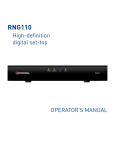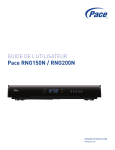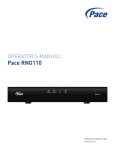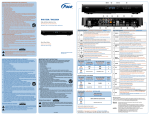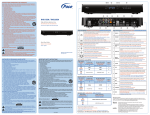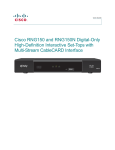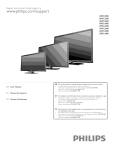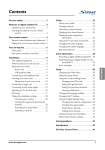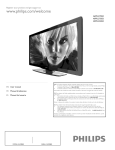Download Pace RNG150N / RNG200N - User Guide - English
Transcript
USER GUIDE Pace RNG150N / RNG200N BRINGING TECHNOLOGY HOME www.pace.com CONTENTS This guide covers both the RNG150N and the RNG200N set-tops. They are very similar, but the RNG200N has an internal hard disk for recording programs. SAFETY INFORMATION................................................................................................... 3 REAR PANEL................................................................................................................... 6 CONNECTING THE EQUIPMENT..................................................................................... 7 Setup A - Home theater system with HDTV (HDMI connection)................................. 8 Setup B - Home theater system with HDTV (Component video / YPbPr connection).9 Connecting the power supply unit to your set-top.................................................... 10 Connecting equipment to the wall AC outlets........................................................... 10 Turning your set-top on and off................................................................................ 10 Lightning storms...................................................................................................... 10 Using your remote control........................................................................................ 10 OPERATING YOUR SET-TOP......................................................................................... 11 Displaying a picture on your HDTV screen............................................................... 11 The front-panel lights............................................................................................... 11 Using DVR (digital video recorder) functions........................................................... 12 Using an external hard disk...................................................................................... 12 Using Zoom to change the picture............................................................................ 13 MAKING USER SETTINGS............................................................................................ 14 About User Settings.................................................................................................. 14 About the TV Aspect Ratio........................................................................................ 14 About TV Display Capability (resolution settings)..................................................... 15 Setting Auto Pillarbox............................................................................................... 16 Making Closed Caption Settings............................................................................... 17 Making Front-Panel Settings.................................................................................... 17 Making HDMI Settings.............................................................................................. 18 Removing the User Settings menus from the TV screen.......................................... 18 Restoring the factory default settings....................................................................... 19 USING THE SETUP MENUS.......................................................................................... 20 SOLVING PROBLEMS................................................................................................... 21 TERMS AND CONDITIONS FOR USE OF SOFTWARE (“TERMS”)................................. 23 This guide describes some on-screen displays such as menus. These may change in the future, if the set-top’s software is updated over the cable. However, the way that you use the menus will remain similar to the way described in this guide. This product incorporates copyright protection technology that is protected by U.S. patents and other intellectual property rights. Use of this copyright protection technology must be authorized by Rovi corporation, and is intended for home and other limited pay-per-view uses only unless otherwise authorized by Rovi corporation. Reverse engineering or disassembly is prohibited. Manufactured under license from Dolby Laboratories. Dolby and the double-D symbol are trademarks of Dolby Laboratories. ® HDMI, the HDMI Logo and High-Definition Multimedia Interface are trademarks or registered trademarks of HDMI Licensing LLC in the United States and other countries. CableCARD™ is a trademark of Cable Television Laboratories, Inc. Other trademarks listed herein are the property of their respective owners. © 2011 Pace plc. All rights reserved. Pace and are trademarks and/or registered trademarks of Pace plc RNG150N / RNG200N USER GUIDE (501-3340000) C019/C020 2 SAFETY INFORMATION This digital set-top has been manufactured and tested with your safety in mind. However, improper use can result in potential electric shock or fire hazards. To avoid defeating the safeguards that have been built into your set-top, please observe the precautions discussed in this document. Warnings on the power supply unit CAUTION IMPORTANT SAFETY INSTRUCTIONS Before you install or use the apparatus, you must read and understand these Important Safety Instructions. At all times when using the apparatus you must follow these Important Safety Instructions to reduce the risk of fire, electrical shock and injury to persons. 1. Read these instructions. RISK OF ELECTRIC SHOCK DO NOT OPEN 2. Keep these instructions. The lightning flash with arrowhead symbol, within a triangle, is intended to alert you to the presence of uninsulated “dangerous” voltages within your set-top’s enclosure that may be of sufficient magnitude to constitute a risk of electric shock to persons. The exclamation point within a triangle is intended to alert you to the presence of important instructions in the literature accompanying your set-top. To ensure correct operation, use this set-top only with the Pace-approved power supply unit provided. If you use an unapproved alternative, you will invalidate the warranty. Other warnings To reduce the risk of electric shock, do not remove the cover of your settop. There are no user-serviceable parts inside it. Do not perform any servicing unless you are qualified to do so. Refer all servicing to qualified service personnel. Servicing the set-top yourself will invalidate the warranty. To reduce the risk of fire or electric shock, do not expose this set-top to rain or moisture. On the rear panel of your set-top there is a tamper-evident label that states ‘Warranty void if broken or removed’. To avoid possible damage to the internal hard disk (if fitted), do not pick up or move your set-top while it is connected to the power supply. If you want to move your set-top, first stop any recording, then turn off your set-top and wait 60 seconds before disconnecting it. You should handle your set-top carefully, as any damage you cause to an internal hard disk (or any other component) will invalidate your warranty. Installation The installation of your set-top should be carried out by a qualified installer and should conform to local codes. Note to the installer This reminder is provided to call the attention of the cable-TV-system installer to Section 820 of the National Electrical Code (USA), which provides guidelines for proper grounding and, in particular, specifies that the cable ground shall be connected to the grounding system of the building, as close to the point of cable entry as is practical. 3. Heed all warnings. 4. Follow all instructions. 5. Do not use this apparatus near water. 6. Clean only with dry cloth. 7. Do not block any ventilation openings. Install in accordance with the manufacturer’s instructions. 8. Do not install near any heat sources such as radiators, heat registers, stoves, or other apparatus (including amplifiers) that produce heat. 9. Do not defeat the safety purpose of the polarized or groundingtype plug. A polarized plug has two blades with one wider than the other. A grounding type plug has two blades and a third grounding prong. The wide blade or the third prong are provided for your safety. If the provided plug does not fit into the outlet, consult an electrician for replacement of the obsolete outlet. 10.Protect the power cord from being walked on or pinched particularly at plugs, convenience receptacles, and the point where they exit from the apparatus. 11.Only use attachments/accessories specified by the manufacturer. 12.Use only with the cart, stand, tripod, bracket, or table specified by the manufacturer, or sold with the apparatus. When a cart is used, use caution when moving the cart/apparatus combination to avoid injury from tip-over. 13.Unplug this apparatus during lightning storms or when unused for long periods of time. 14.Refer all servicing to qualified service personnel. Servicing is required when the apparatus has been damaged in any way, such as power-supply cord or plug is damaged, liquid has been spilled or objects have fallen into the apparatus, the apparatus has been exposed to rain or moisture, does not operate normally, or has been dropped. Service address: Pace Americas Inc. 3701 FAU Boulevard, Suite 200, Boca Raton, Florida 33431 U.S.A. RNG150N / RNG200N USER GUIDE (501-3340000) C019/C020 3 SAFETY INFORMATION (cont.) In addition to the Important Safety Instructions, please read the Safety Information below. Power sources The model number, serial number, and electrical rating of this set-top are on a label on its base. You must operate your set-top only from the type of power source indicated on the marking label. If you are not sure of the type of power supply to your home, consult your dealer or local power company. If you move your set-top between locations at different temperatures, allow it to reach room temperature before you apply power to it. Overloading Do not overload wall AC outlets, extension cords or other power outlets as this can result in a risk of fire or electric shock. Lightning For added protection for your set-top during a lightning storm, or when it is left unattended and unused for long periods of time, disconnect your set-top from the power supply and disconnect the cable system from your set-top. See also item 13 in the Important Safety Instructions. Ambient temperature The operating temperature range of your set-top is 32-104°F. If the ambient temperature around your set-top falls outside this range, you must correct this in order for your set-top to work correctly and safely. For example, if the temperature is too high, make sure there is sufficient ventilation (see below) and that your set-top is not directly on top of or underneath other equipment. Ventilation Slots and openings in the casing of your set-top are provided for ventilation, to ensure reliable operation of your set-top and to protect it from overheating. • Never block the ventilation openings by placing your set-top on a bed, sofa, rug, or other similar surface. Place it on a hard, flat surface. • Never cover the ventilation openings with items such as newspapers, table-cloths, or curtains. • You can place your set-top near other consumer electronics devices, such as stereo amplifiers or televisions, but you must not place it directly on top or underneath them. Water and moisture Do not expose your set-top to rain or moisture, dripping or splashing, and ensure that no objects filled with liquids, such as vases, are placed on your set-top. See also item 5 in the Important Safety Instructions. Entry of objects and liquids Never push objects of any kind into your set-top through openings as they may touch dangerous voltage points or short-out parts that could result in fire or electric shock. Never spill liquid of any kind on your set-top. Transporting Move the combination of set-top and cart with care. Quick stops, excessive force and uneven surfaces may cause the combination of set-top and cart to overturn. See also item 12 in the Important Safety Instructions. Placement and mounting Do not place your set-top on an unstable or uneven surface. Your set-top may fall, causing serious injury to a child or adult and serious damage to your set-top. If you mount your set-top, for example to a wall or ceiling, follow the manufacturer’s instructions and use a mounting accessory recommended by the manufacturer. See also item 12 in the Important Safety Instructions. Risk of fire or scorching Never place naked flame sources, such as lighted candles, on or adjacent to your set-top. Replacement parts When replacement parts are required, be sure that the service technician has used replacement parts specified by the manufacturer or that have the same characteristics as the original part. Unauthorized substitutions may result in fire, electric shock or other hazards. See also item 14 in the Important Safety Instructions. Safety check Upon completion of any servicing or repairs to your set-top, ask the service technician to perform safety checks to determine that your set-top is in its proper operating condition. See also item 14 in the Important Safety Instructions. SAVE THIS INFORMATION FOR FUTURE REFERENCE • Do not place your set-top in a built-in installation such as a bookcase or rack unless proper ventilation is provided and you have adhered to the manufacturer’s instructions. • Maintain a minimum distance of three inches around your set-top for sufficient ventilation. 3 in. 3 in. 3 in. See also item 7 in the Important Safety Instructions. RNG150N / RNG200N USER GUIDE (501-3340000) C019/C020 4 SAFETY INFORMATION (cont.) Safety aspects of connections Regulatory information Full details of the rear panel are on page 6. CAUTION: Do not attempt to modify your set-top without written authorization from the manufacturer. Unauthorized modification could void your authority to operate your set-top. Connecting Do not connect your set-top (or any other equipment such as a TV or VCR) to the power supply until you have properly connected all the other cables. Your set-top is designed for use only with the supplied power supply unit. On the power supply unit there is a label that specifies the correct AC power supply input for it. Do not connect the power supply unit to any supply other than this. Always connect the 12 volt DC cord from the power supply unit to your set-top before you insert the AC power cord from the power supply unit into the wall AC outlet. Disconnecting To disconnect power from your set-top, always detach the power supply unit from the wall AC outlet (rather than remove the 12 volt cord from your set-top). NOTE Your set-top has been tested and found to comply with the limits for a Class B digital device, pursuant to Part 15 of the FCC Rules. These limits are designed to provide reasonable protection against harmful interference in a residential installation. Your set-top generates, uses and can radiate radio-frequency energy and, if not installed and used in accordance with the instructions, may cause harmful interference to radio communications. However, there is no guarantee that interference will not occur in a particular installation. If your set-top does cause harmful interference to radio or television reception, which can be determined by turning your set-top off and on, you are encouraged to try to correct the interference by one or more of the following measures. Therefore you must install your set-top near to the wall AC outlet, which should be easily accessible. • Reorient or relocate the receiving antenna. If you are in any doubt about the power supply cord, its plug or its connection, consult a qualified electrician. • Connect your set-top to an outlet on a circuit different from that to which the receiver is connected. • Increase the separation between your set-top and the receiver. • Consult your dealer or an experienced radio/TV technician for help. GITAL DIO OUT DIGITAL AUDIO OUT The CABLE IN connector is designed for connection to a cable network only. You must not connect any other equipment, such as a VCR, to this input. POWER INPUT The model number, serial number, and electrical rating of this set-top are on a label on its base. 12 volt power supply unit To ensure correct operation, use this set-top only with the Pace-approved power supply unit provided. If you use an unapproved alternative, you will invalidate the warranty. RNG150N / RNG200N USER GUIDE (501-3340000) C019/C020 5 REAR PANEL CABLE IN From cable service-provider VIDEO OUT Composite video output ETHERNET For use in home networks DIGITAL AUDIO OUT Electrical S/PDIF audio output AUDIO OUT Audio outputs (stereo, R and L) HDMI® Video and audio output for digital HDTV S-VIDEO S-video output IR RECEIVE Infra-red input from a remote “eye” CableCARD™ module (behind cover) Removal will interrupt your service DC IN +12V power input (Make this connection last of all) DIGITAL AUDIO OUT COMPONENT VIDEO Component video output for analog HDTV DIGITAL AUDIO OUT Optical S/PDIF audio output TO TV RF output to TV (or VCR) USB (Universal Serial Bus) port For future use eSATA For connection to an external hard disk 1394 For connection to a 1394-compatible device CABLE IN Connect the cable service here. ETHERNET For use in home networks. VIDEO OUT Connect to the composite video input on your VCR (or a standard TV). AUDIO OUT Connect to the L and R audio inputs on your stereo TV, stereo VCR, or optional stereo amplifier. DIGITAL AUDIO OUT (electrical) Connect to the electrical digital audio input on optional digital audio equipment, such as an audio decoder or home theater receiver. S-VIDEO Connect to the S-video input (if present) on your VCR or TV. HDMI (High Definition Multimedia Interface) If your HDTV has an HDMI, connect it here for a digital audio/video connection (instead of using the AUDIO and three analog COMPONENT VIDEO connectors). CableCARD module Removal will interrupt your service. IR RECEIVE Connect to an optional remote “eye”. DC IN +12V Connect your set-top’s power supply unit here. Make this connection last of all. COMPONENT VIDEO If your HDTV does not have an HDMI, connect your HDTV here. DIGITAL AUDIO OUT (optical) Connect to the optical digital audio input on optional digital audio equipment. TO TV Connect to the RF/antenna input on your TV or VCR (optional). USB (Universal Serial Bus) port Connect to compatible optional equipment that supports a USB 2.0 interface (future use). eSATA Connect to an optional external hard disk (if this feature is enabled by your cable service-provider). 1394 Connect to a TV with a 1394 port or to any other 1394-compatible device. RNG150N / RNG200N USER GUIDE (501-3340000) C019/C020 6 CONNECTING THE EQUIPMENT Possible setups In order for you to view programs broadcast in high-definition, your set-top must be connected to a suitable HDTV or computer monitor. Your set-top is also compatible with standard-definition TVs and VCRs. Your equipment should have been connected up by your installer. However, if you need to disconnect and reconnect your equipment, read pages 8 and 9. There are two typical connection setups for an HDTV, VCR, DVD player, and home theater receiver. You can take advantage of the digital audio output from your set-top by connecting a suitable cable between your home theater receiver and the DIGITAL AUDIO OUT connector (as shown in the diagrams). How you set up your equipment may depend on your home theater receiver. For example, the optical audio input may be associated with a particular video input. Consult your home theater user guide for further details. The setups shown on pages 8 and 9 make efficient use of the connectors on your set-top. However, depending on your other equipment and the connectors on it, the person who installed your system may have chosen to connect things differently. Recording programs Both setups allow stereo recording and play-back of video tapes. You hear stereo sound from the home theater’s loudspeakers. However, the RNG200N has an internal hard disk for recording programs. You can also attach an external hard disk to the rear-panel eSATA port. Both set-tops can also be used in a home network with separate network-attached storage, so that recordings can be stored centrally and viewed in at various locations in your home. The equipment in a home network must be installed by a qualified installer. RF connections Although the RF cables (shown by dashed lines in the diagrams) are not absolutely necessary, we recommend that you connect them as a back-up. If you use the RF cables, you must tune your TV (and VCR) to your set-top’s VHF output channel (3 or 4: consult your cable service-provider to find which channel it is for your location). Consult the manuals supplied with your TV and VCR for information on how to tune. WARNINGS Do not connect your set-top (or any other equipment such as a TV or VCR) to the power supply until you have properly connected all the other cables. Disconnect your set-top’s power supply unit from the AC power supply before you disconnect any other equipment from its rear panel. The only way to disconnect your set-top from the AC power supply is to remove the power supply unit from the wall AC outlet (or switch the wall AC outlet switch, if present, to its OFF position). Your set-top must therefore be installed near to the wall AC outlet, The cable input is designed for connection to a cable network only. You must not connect any other equipment, such as a VCR, to this input. Any cable connected to DIGITAL AUDIO OUT (the upper RCA jack) must be 75 ohm coaxial cable, not regular audio cable. NOTE Copy protection via an HDMI secure link The HDMI link between your set-top and your HDTV should be a secure link. When your set-top is attached via an HDMI cable to an HDCP-compliant (High-bandwidth Digital Content Protection) HDTV, the HDTV and set-top negotiate a secure link, which allows your set-top to transmit full resolution video (picture) to your HDTV. Not all HDTVs support HDCP. If your set-top is connected to an HDTV that does not support it, the following may be displayed: Your HDTV does not support HDCP. Please use the YPbPr component connection to watch TV. The HDMI output is then disabled, so no picture is transmitted from this connector. In that case, use the component video connectors to connect up (see Setup B). RNG150N / RNG200N USER GUIDE (501-3340000) C019/C020 7 CONNECTING THE EQUIPMENT (cont.) Setup A - Home theater system with HDTV (HDMI connection) Setup A uses an HDMI connector to connect to the HDTV. This displays the highest quality picture on the HDTV and also means there will be no picture degradation on any copy-protected programs (provided the link remains secure – see page 7). VCR POWER LEFT AUDIO IN LEFT AUDIO OUT RIGHT AUDIO IN RIGHT AUDIO OUT VIDEO IN VIDEO OUT TV / RF OUT HDTV RIGHT AUDIO IN ANTENNA/ RF IN LEFT AUDIO IN ANTENNA/ RF IN VIDEO IN COMPONENT VIDEO IN COMPONENT VIDEO OUT DVD DIGITAL AUDIO OUT POWER COAXIAL OPTICAL HDMI Y IN Y PB IN PB/CB PR IN POWER PR/CR WALL AC OUTLETS HOME THEATER RECEIVER VCR IN LEFT AUDIO IN RIGHT AUDIO IN POWER DIGITAL AUDIO IN COAXIAL AUDIO IN OPTICAL AUDIO IN VIDEO IN WALL AC OUTLET DIGITAL AUDIO OUT CABLE INPUT WALL AC OUTLET NOTE This diagram shows a video path from the set-top to a VCR to allow recording by the VCR. It shows a video path from the VCR to the TV to allow playback of videos. Video signals fed through a VCR may be affected by copyright protection systems, which can cause picture distortion on your TV. Do not, therefore, use a path through a VCR to watch your set-top programs. Use the HDMI path or an alternate direct video path from your set-top to your TV. Remember to select the correct input on your TV. RNG150N / RNG200N USER GUIDE (501-3340000) C019/C020 NOTE This diagram shows power cords that have 2-blade polarized plugs. You may need to use a different type of plug in the region where you live. 8 CONNECTING THE EQUIPMENT (cont.) Setup B - Home theater system with HDTV (Component video / YPbPr connection) Setup B uses a component video connection to connect to the HDTV. This displays a high definition picture on your TV. VCR POWER LEFT AUDIO IN LEFT AUDIO OUT RIGHT AUDIO IN RIGHT AUDIO OUT VIDEO IN VIDEO OUT TV / RF OUT HDTV RIGHT AUDIO IN ANTENNA/ RF IN LEFT AUDIO IN ANTENNA/ RF IN VIDEO IN COMPONENT VIDEO IN DVD DIGITAL AUDIO OUT POWER WALL AC OUTLETS COAXIAL OPTICAL HOME THEATER RECEIVER VCR IN LEFT AUDIO IN RIGHT AUDIO IN POWER S-VIDEO IN S-VIDEO OUT Y IN POWER PB IN PR IN DIGITAL AUDIO IN COAXIAL AUDIO IN OPTICAL AUDIO IN VIDEO IN WALL AC OUTLET DIGITAL AUDIO OUT CABLE INPUT WALL AC OUTLET NOTE This diagram shows a video path from the set-top to a VCR to allow recording by the VCR. It shows a video path from the VCR to the TV to allow playback of videos. Video signals fed through a VCR may be affected by copyright protection systems, which can cause picture distortion on your TV. Do not, therefore, use a path through a VCR to watch your set-top programs. Use the component video path or an alternate direct video path from your set-top to your TV. Remember to select the correct input on your TV. RNG150N / RNG200N USER GUIDE (501-3340000) C019/C020 NOTE This diagram shows power cords that have 2-blade polarized plugs. You may need to use a different type of plug in the region where you live. 9 CONNECTING THE EQUIPMENT (cont.) WARNINGS Do not connect your set-top (or any other equipment such as a TV or VCR) to the power supply until you have properly connected all the other cables. Do not defeat the safety purpose of the polarized or grounding-type plug. A polarized plug has two blades with one wider than the other. A grounding type plug has two blades and a third grounding prong. The wide blade or the third prong are provided for your safety. Connecting the power supply unit to your set-top Before you insert the power supply unit into the wall AC outlet, connect the 12 volt DC cord from the power supply unit to the socket labeled “DC IN +12 V” on your set-top’s rear panel. Connecting equipment to the wall AC outlets Connect your set-top’s power supply unit, and the plugs on the power cords from your TV, VCR, and any other equipment, into wall AC outlets. If these outlets have switches, switch them ON. Turning your set-top on and off After you have connected your set-top’s power supply unit to the wall AC outlet (and switched this outlet ON, if it has a switch), press the POWER button on your remote control to turn your set-top on (making sure your remote control is set to control your set-top). The (power) light on your set-top’s front panel should light up green, to show that your set-top is on. The (power) light lights up green. To turn your set-top on or off at any time, press the POWER button on your remote control. Never turn off your set-top by simply disconnecting it from the power supply. If you need to disconnect your set-top, first stop any recording (if applicable). Then turn off your set-top by pressing the POWER button on your remote control, so that the (power) light goes off. Then wait 60 seconds before removing the power supply unit from the wall AC outlet. Power Saving: To save power and money, and to reduce greenhouse gas emissions, turn off your set-top, using the POWER button on your remote control, when it is not in use. Front panel display, showing the time (see page 20) Lightning storms Disconnect your set-top’s power cord during lightning storms. A lightning storm may affect your set-top, if it is on during the storm. It may appear that it has stopped working, but you can easily restore its operation as follows: Unplug your set-top’s power supply unit from the wall AC outlet. Then plug this power supply unit in again at the wall AC outlet (and, if there is a switch by this outlet, switch it to its ON position). Using your remote control Your cable TV service-provider determines the digital channels, services, and screen information that you see on your TV when you use your set-top and its remote control. Consult the information supplied by your cable service-provider for details on how to make the most of the digital cable services. Also read the operating instructions that are supplied with your remote control. RNG150N / RNG200N USER GUIDE (501-3340000) C019/C020 NOTE IMPORTANT: Unless there is a lightning storm or you will be away from your home for a long time, do not unplug your set-top’s power supply unit at the wall AC outlet (or do not switch it off there, if the outlet has a switch). Your set-top cannot be updated with new features, through the cable, if it is disconnected from the power supply. 10 OPERATING YOUR SET-TOP Displaying a picture on your HDTV screen If your set-top is connected to your HDTV’s component video or HDMI input and is turned on (the (power) light is green), but your HDTV does not initially display a picture from your set-top, your HDTV may not support your set-top’s current output resolution (for further details on resolutions, see page 15). You therefore need to change your set-top’s output resolution as follows: 1. First press the POWER button on your remote control ( button. Current output resolution from your set-top Video Format : 1080i (power) light goes off), then press the MENU 2. Next, press the ZOOM button on your remote control (the button could be labeled ASPECT) until a picture appears. Each button-press changes your set-top’s output resolution, which also appears on your TV screen. After a few seconds, you should see the PACE USER SETTINGS menu. 3. Press the POWER button to remove this menu and return to regular viewing. PACE USER SETTINGS TV Aspect Ratio TV Display Capability Auto Pillarbox Closed Captions Front Panel Settings HDMI Settings Restore Defaults Select[OK] Exit[POWER] The front-panel lights (power) light Lights green when your set-top is on; not lighted when your set-top is in standby or is disconnected from the power supply (message) light Lights yellow when there is an unread message and when you make user settings (to show current setting) Display Shows the time or the current channel number, and the setting when you make user settings (record) light Lights red while a program is being recorded RNG150N / RNG200N USER GUIDE (501-3340000) C019/C020 (remote) light Flashes green when your set-top receives a signal from your remote control Resolution lights Light up blue when your set-top has an input signal at the resolution indicated 11 OPERATING YOUR SET-TOP (cont.) Using DVR (digital video recorder) functions If you have an RNG200N set-top, it has an internal hard disk to provide DVR functions. Both the RNG150N and the RNG200N have a rear-panel eSATA port to which you can connect an external hard disk (see further detail below). This can give DVR functionality to the RGN150N and increase the recording capacity for the RNG200N. Your set-top can also be connected into a home network. This allows several set-tops to record to a separate hard disk called a network attached storage (NAS) unit. In this way, recordings can shared around your home (Multiroom). You need a qualified installer to set up such a home network for you and you should then consult the information supplied with your NAS unit. You can use the DVR functionality to record and play back television programs, giving you much more control of your viewing experience. For example, you can pause live television and resume viewing from the point at which you left off. You can record many more hours than you can by using a VCR or DVD recorder. There is a red light on your set-top’s front panel to show when recording is taking place. With your set-top you can: • • • • • • • • • • • • pause live TV; instantly replay live TV; fast-forward up to the point of live TV; watch a scene in slow motion; rewind through a program you have been watching; record high definition digital pictures (as well as the regular standard definition); record one program while watching another; record two programs while watching a previously recorded program; schedule your set-top to record a program or a whole series; fully manage your stored recordings; back up your digital recordings to a VCR or DVD recorder; retain full control over any parental viewing restrictions you have set up. NOTES Exact DVR functionality depends on your on-screen program guide. For more details, consult the information supplied by your cable service-provider. Do not confuse recording to a hard disk with recording to a separate VCR or DVD recorder, as mentioned on page 7. The DVR functions will not work if an RNG200N set-top becomes overheated. The internal hard disk will be temporarily disabled. Refer to the set-top’s ventilation requirements on page 4. You control your set-top’s DVR functions using your remote control; consult the information supplied by your cable service-provider for more details. Also read the operating instructions that are supplied with your remote control. Using an external hard disk Your cable service-provider may enable a feature that allows an external hard disk to work with your set-top. If this is the case, most major brands of serial ATA hard disk, connected to the eSATA port, are supported. You must not connect an external hard disk to the USB port. If you use an external hard disk with an RNG200N set-top, it gives extra recording capacity, but you cannot choose which disk (internal or external) your set-top will record onto. It automatically chooses the one with more empty space. The recordings on the external hard disk are uniquely linked to the set-top on which they were made, so you cannot play them back or delete them with a different set-top. Do you want to format the external hard drive? YES NO Connecting an external hard disk 1. Stop any recording you are making to your set-top’s internal hard disk (applicable to RNG200N). 2. Turn off your set-top with the POWER button, then wait 60 seconds before disconnecting its power supply unit from the wall AC outlet. (You must not “hot plug” an external hard disk.) 3. Connect the external hard disk, using an appropriate cable, to the eSATA connector on your set-top. 4. Apply power to the external hard disk. Formatting the Hard drive. Please wait... 5. Reconnect your set-top’s power supply unit to the wall AC outlet and turn it on with the POWER button. If the external disk needs formatting, your set-top informs you by displaying a pop-up dialog box on your TV screen (see right). 6. Use the arrow and OK/Select buttons to select YES, and the formatting begins. RNG150N / RNG200N USER GUIDE (501-3340000) C019/C020 12 OPERATING YOUR SET-TOP (cont.) Using Zoom to change the picture Making the appropriate TV Aspect Ratio and TV Display Capability settings (see pages 14 through 16) should ensure that the picture on your TV screen is not distorted (stretched or squashed) and that it fills as much of the screen as possible. However, even if you have selected the correct settings, there may be times when a program appears with black borders either at the top and bottom or at the sides of the picture (or sometimes even all the way around the picture). This happens because the aspect ratio (shape) of the transmitted program does not match the aspect ratio of your HDTV, or because the transmitted program includes black borders as part of the transmission (see right). A 4:3 transmission, with a 16:9 picture. Dark bars are added at the top and bottom of the transmission. Your remote control should have a “zoom function” button (could be labeled ZOOM or ASPECT), which you can use to change the TV picture until it appears as you want it to. 1. Press the “zoom function” button once to change the display. 2. Press it again to change the display again. Continue to press it in this way until the picture appears as you want it to. Note: The effect that this button has on transmissions depends on the transmission itself. On some transmissions it may have no effect at all. RNG150N / RNG200N USER GUIDE (501-3340000) C019/C020 A 16:9 transmission, with a 4:3 picture in it. Dark bars are added at the sides of the transmission. 13 MAKING USER SETTINGS About User Settings Your installer should have made the correct settings so that your set-top is compatible with your HDTV or TV. However, you may wish to change some settings, for example if you purchase a new HDTV. You can make the following settings and you can also reset them to the factory defaults. • TV Aspect Ratio (the screen’s width-to-height ratio, or shape) • TV Display Capability (screen resolution) • Auto Pillarbox • Closed Captions • Front Panel Settings • HDMI Settings You use the buttons on your remote control to make the settings and you can see them on the front-panel display. You can also look at on-screen menus, but note that, until your set-top has been set up to match the display capability of your TV (see page 11), these menus may not be visible. Putting your set-top into User Settings mode 1. Make sure that your set-top is turned on (the (power) light is green). 2. Press the POWER button on your remote control (the button. (power) light goes off), then press the Menu “ASPt” (or another of the seven “words” shown right) should then appear on the front-panel display. If it does not appear, press the Menu button again. You should see the PACE USER SETTINGS menu on your TV screen. 3. When you have finished making changes (see pages 14 through 18), press the POWER button to remove the PACE USER SETTINGS menu and return to regular viewing. PACE USER SETTINGS TV Aspect Ratio TV Display Capability Auto Pillarbox Closed Captions Front Panel Settings HDMI Settings Restore Defaults Select[OK] Exit[POWER] About the TV Aspect Ratio The TV that you have connected to your set-top has an aspect ratio (width-to-height ratio) of 4:3 (basic/ standard) or 16:9 (widescreen). You must set the appropriate TV Aspect Ratio (4:3 or 16:9) on your set-top, so that it is compatible with your TV. Setting the TV Aspect Ratio If you have not done so already, put your set-top into User Settings mode, as described above. 4:3 standard TV, EDTV or HDTV 1. Press the U or D button on your remote control until the front panel shows “ASPt”. 2. Press the R button. The current TV Aspect Ratio setting (“4:3” or “16:9”) appears on the front panel. Whenever the current setting is displayed, the MESSAGE light will be lighted. You may also see the menu, shown right, on your TV screen. In the menu, the current setting has > in front of it. 3. Press the U or D button until the TV Aspect Ratio you want appears on the front panel and is highlighted in the menu. 4. Press the OK/Select button to confirm your choice and change to that TV Aspect Ratio. 5. Press the L button. The front panel will display “ASPt” again and the PACE USER SETTINGS menu reappears. 16:9 HDTV TV Aspect Ratio 4:3 >16:9 To continue making the settings, see the next section. RNG150N / RNG200N USER GUIDE (501-3340000) C019/C020 14 MAKING USER SETTINGS (cont.) About TV Display Capability (resolution settings) • Your set-top can transmit pictures to your TV in a range of resolutions (also called “Display Capabilities” - see below for the settings available). Generally, higher screen resolutions give better quality pictures. However, the quality always depends on how the program was originally transmitted. • Different TVs display different screen resolutions. For example, standard TVs display “480i”, EDTVs (Enhanced Definition TVs) display “480p”, and most HDTVs display “1080p”, “1080i”, or “720p”. Many HDTVs will display at more than one resolution. For more information, see the information supplied with your HDTV. See also the note, right. You may need to make appropriate TV Display Capability settings on your set-top, so that it is compatible with your TV. In order to display the best picture every time, you must select every resolution that your TV is capable of displaying. This ensures that programs are displayed with minimum distortion. There are five front-panel lights for the various resolutions. The appropriate one lights up to show the resolution of the transmission your set-top is currently receiving (not the resolution of the signals at the outputs of your set-top). TV Display Capability settings • 480i is standard definition NTSC and is transmitted in a 4:3 aspect ratio (see right). • 480p is enhanced digital TV and can be transmitted in either a 4:3 or 16:9 aspect ratio. • 720p,1080i, and 1080p are HDTV and are transmitted in a 16:9 aspect ratio (see right). 480i transmission: The aspect ratio is 4:3 1080i transmission: The aspect ratio is 16:9 Changing the TV Display Capability If you have not already done so, put your set-top into User Settings mode, as described on page 14. NOTE When your HDTV and set-top are connected by an HDMI connector, your set-top gets information from your HDTV about the HDTV’s display capability. Your set-top uses this information to adjust its TV Display Capability settings. Your set-top also records your HDTV’s ID (identification), so that only one HDTV is supported at any one time. When your HDTV has updated your set-top’s TV Display Capability settings, you may change them if you wish. Your changes will then be stored with the ID. You can restore your set-top’s TV Display Capability settings to their factory values, as described on page 19. You can also restore your set-top to the settings that your HDTV has passed to your set-top. To do this you must first restore the factory settings while the HDMI cable is disconnected from your set-top, then reconnect your HDTV via the HDMI cable. 1. Press the U or D button on your remote control until the front panel shows “reS” (short for resolution). On the PACE USER SETTINGS menu, TV Display Capability is highlighted when “reS” is on the front panel. 2. Press the R button when you see “reS” on the front panel. The front panel shows the TV display capability that was last selected, so it could show 480i, 480P, 720P, 1080i, 1080p24 Pass*, 1080p30 Pass* or 1080p60 (the last four settings are displayed as 1080). The TV Display Capability menu, shown right, appears on your TV screen. 3. Press the U or D button to highlight each resolution in turn on the menu and, for each one, press the OK/Select button if you wish to change the setting (the setting changes between “YES” and “NO” each time you press OK/Select). If, at any stage in this process, the menu disappears from the screen, immediately press the OK/Select button to restore the menu. 4. When you are satisfied that all the TV resolutions are correct, press the L button. The front panel shows “reS” again and the PACE USER SETTINGS menu reappears. To continue making the settings, see the next section. * NOTE If your HDTV is 1080p-compliant and connected by HDMI, setting “1080p24 Pass” to YES causes 1080p/24 transmissions (at 24 frames per second) to be displayed at 1080p/24. Likewise, setting “1080p30 Pass” to YES causes 1080p/30 transmissions (at 30 frames per second) to be displayed at 1080p/30. The HDMI-connected HDTV may report that it is not 1080p-compliant and set “1080p24 Pass” (or “1080p30 Pass”) to NO. In this case 1080p transmissions will be output at one of the other resolutions (1080i, 720p, 480p, or 480i). If you override this NO setting and set YES, you may see nothing for 1080p transmissions. If the HDTV is not connected by HDMI, “HDMI Cable Required” is displayed and you cannot set “1080p24 Pass” or “1080p30 Pass” to either YES or NO. RNG150N / RNG200N USER GUIDE (501-3340000) C019/C020 If the highlighted resolution is currently set, the MESSAGE light is lighted and YES is on the menu TV Display Capability 1080i : YES 720p : NO 480p : YES 480i : YES 1080p24 Pass : NO 1080p30 Pass : NO 1080p60 : NO 15 MAKING USER SETTINGS (cont.) Further information about the TV Display Capability The TV Display Capability settings relate to equipment that is connected to the HDMI and COMPONENT VIDEO connectors because the settings control the output at those connectors. If equipment is connected via an HDMI cable, that equipment may also pass information back to your set-top, which may affect the settings that are available. Transmissions at 480i, 480p, 720p, or 1080i can never be output at 1080p. Generally, the TV Display Capability settings do not affect equipment connected to the VIDEO OUT and S-VIDEO connectors, because the output at these connectors is always standard definition 480i. Setting Auto Pillarbox If your TV is a 16:9 TV that does not automatically detect 4:3 transmissions (and therefore does not add black bars to the sides of the picture), then 4:3 transmissions may display “stretched” to fit the 16:9 screen. If you do not want this effect, you can set your set-top to add black bars to the 4:3 picture, so that it is transmitted to your TV at a 16:9 aspect ratio. See the example below. 4:3 transmission 16:9 TV with no automatic detection of 4:3, Auto-pillarbox switched off 16:9 TV with no automatic detection of 4:3, Auto-pillarbox switched on Changing the Auto Pillarbox setting If you have not done so already, put your set-top into User Settings mode, as described on page 14. 1. Press the U or D button on your remote control until the front panel shows “PiLL”. On the PACE USER SETTINGS menu, Auto Pillarbox is highlighted when “PiLL” is on the front panel. 2. Press the R button. The Auto Pillarbox menu appears on your TV screen. The current Auto Pillarbox setting (“YeS” = switched on, or “no” = switched off) is displayed on the front panel. 3. If you want to change the setting, press U or D. Press the OK/Select button to confirm your choice and change to the new setting. 4. Press the L button. The front panel shows “PiLL” again and the PACE USER SETTINGS menu reappears. To continue making the settings, see the next section. NOTE Auto Pillarbox YES >NO > shows current setting, as does a lighted MESSAGE light 16:9 picture in a 4:3 transmission Sometimes, 4:3 transmissions may contain a 16:9 picture, with black borders at the top and bottom. On a 16:9 TV, this may display with black borders all the way around the picture. To remove these borders, you can use the “Zoom function” button on your remote control (could be labeled ZOOM or ASPECT). See the example below. For more information about using “Zoom”, see page 13. 4:3 transmission 16:9 TV with no automatic detection of 4:3, Auto-pillarbox switched off 16:9 TV with no automatic Use 'Zoom' to increase the picture size. (Note: the picture may lose some detection of 4:3, definition due to the expansion) Auto-pillarbox switched on RNG150N / RNG200N USER GUIDE (501-3340000) C019/C020 16 MAKING USER SETTINGS (cont.) Making Closed Caption Settings Closed captioning is a means of displaying alerts and subtitles on your TV screen, superimposed on whatever you are watching. You can turn closed captions on or off, as required, and you can also change the closed captions’ appearance. Turning closed captions on or off If you have not done so already, put your set-top into User Settings mode, as described on page 14. 1. Press the U or D button on your remote control until the front panel shows “CC”. On the PACE USER SETTINGS menu, Closed Captions is highlighted when “CC” is on the front panel. 2. Press the R button. The Closed Captions menu appears on your TV screen, see right. The current Closed Captions (CC) setting, either “ON” or “OFF” is highlighted on the menu. 3. If you want to change the setting, press the OK/Select button - the setting changes. Closed Captions CC : OFF Configure Captions 4. Press the L button. The front panel shows “CC” again and the PACE USER SETTINGS menu reappears. To continue making the settings, see the next section. Changing the closed captions’ appearance If you want to change the closed captions’ appearance, you can see the effect of your settings by looking at the example below the menu. 1. In the Closed Captions menu, press the D button on your remote control to highlight “Configure Captions”, then press OK/Select. The Configure Captions menu appears, see right. 2. Use the U and D arrows to highlight each option in turn. Use the OK/Select button to choose the setting you want (the setting changes each time you press OK/Select). 3 If you wish to reset all the Closed Caption settings to their default values (mainly Auto), press the D button to highlight “Reset to Defaults” on the menu, then press OK/Select. Configure Captions Size Font Character Color Character Shading Background Color Background Shading Std Def CC Hi Def CC Reset to Defaults : : : : : : : : Auto Auto Auto Auto Auto Auto Auto Service 1 Closed Caption Example 4. When you have made all the changes you want, press L twice to redisplay the PACE USER SETTINGS menu. Making Front-Panel Settings You can use the Front Panel Settings menu to set the brightness level of the front-panel lights (but not the (power) light) when your set-top is being used (“Viewing TV Brightness”) and when it is switched off (“Standby Brightness”). If you have not done so already, put your set-top into User Settings mode, as described on page 14. 1. Press the U or D button on your remote control until the front panel shows “FP”. On the PACE USER SETTINGS menu, Front Panel Settings is highlighted when “FP” is on the front panel. 2. Press the R button. The Front Panel Settings menu, shown right, appears on your TV screen. 3. Press the U or D button to highlight “Standby Brightness” and “Viewing TV Brightness” in turn, as required. Front Panel Settings Standby Brightness : Std Viewing TV Brightness : High 4. For each level, use the OK/Select button to choose the setting you want: “Low”, “Std” (Standard), or “High” (the setting changes each time you press OK/Select). Look at the dimming and brightening of the front-panel lights while you are making the settings, to see the effect of your selections. 5. When you have made all the changes you want, press L to redisplay the PACE USER SETTINGS menu. RNG150N / RNG200N USER GUIDE (501-3340000) C019/C020 17 MAKING USER SETTINGS (cont.) Making HDMI Settings You can use the HDMI Settings menu to choose an Audio Output Mode, and to enable or disable automatic detection of a newly connected HDTV (if it is connected by an HDMI cable). If you have not done so already, put your set-top into User Settings mode, as described on page 14. 1. Press the U or D button on your remote control until the front panel shows “hdni”. On the PACE USER SETTINGS menu, HDMI Settings is highlighted when “hdni” is on the front panel. 2. Press the R button. The HDMI Settings menu appears (see right). 3. Press the U or D button to highlight “Audio Output Mode” or “Disable Auto Detect” as required. 4. Use the OK/Select button to choose the setting you want (the setting changes each time you press OK/ Select). Audio Output Mode has three possible settings: “Auto” (provides the audio format best suited to the connected equipment) “L-PCM” (provides PCM audio only) “Pass Through” (does not change the audio format) HDMI Settings Audio Output Mode : Auto Disable Auto Detect : NO Disable Auto Detect is either “YES” or “NO”. 5. When you have made all the changes you want, press L to redisplay the PACE USER SETTINGS menu. Removing the User Settings menus from the TV screen When you have finished making all the user settings you wish to make, press the POWER button on your remote control to remove the PACE USER SETTINGS menu and return to regular viewing. RNG150N / RNG200N USER GUIDE (501-3340000) C019/C020 18 MAKING USER SETTINGS (cont.) Restoring the factory default settings If you wish, you can restore the user settings to their factory defaults. All the changes you have made will be lost and the settings will revert to those that were programmed in the factory. The factory settings are: PACE USER SETTINGS menu item Options Factory default setting TV Aspect Ratio – 16:9 TV Display Capability 1080i 720p 480p 480i 1080p24 Pass 1080p30 Pass 1080p60 Yes No Yes Yes No No No Auto Pillarbox – No Closed Captions – Off Configure Captions Various All Auto except Hi Def CC, which is Service 1 Front Panel Settings Standby Brightness Std Viewing TV Brightness High HDMI Settings Audio Output Mode Disable Auto Detect Auto No NOTE If your set-top and HDTV are connected via a standard HDMI cable, your HDTV may pass information about the required settings back to your set-top (see page 15). If you wish to restore your set-top’s settings to those created by your HDTV, you must disconnect the HDMI cable from your set-top before you restore the factory default settings. When you reconnect your HDTV to your settop via the HDMI cable, your HDTV will pass back the information again. Always turn off your set-top, wait 60 seconds, then disconnect your set-top’s power supply unit from the wall AC outlet before you connect or disconnect any other equipment to or from its rear panel. If you have not done so already, put your set-top into User Settings mode, as described on page 14. 1. Press the D button on your remote control until the front panel shows “reSt” (short for “restore factory settings”) and Restore Defaults is highlighted on the PACE USER SETTINGS menu. 2. Press the R button. “YeS” appears on your set-top’s front panel and the message: “Restore Default. Press OK to confirm” appears on your TV screen. (If, at this stage, you no longer wish to restore the factory settings, press the L button.) 3. To confirm and restore the factory settings, press the OK/Select button. The factory settings are restored, and the PACE USER SETTINGS menu reappears. 4. If you want to continue changing the settings, see the sections from page 14 onwards. If you have finished changing the settings, press the POWER button on your remote control. Your set-top then switches on with the restored settings. RNG150N / RNG200N USER GUIDE (501-3340000) C019/C020 Restore Defaults Press OK to confirm. 19 USING THE SETUP MENUS In addition to the user settings described on pages 14 through 18, setup menus may be available in your onscreen guide. These should be described in the information provided by your service-provider. There may also be on-screen information to explain these menus. However, certain settings may affect how your set-top and TV work. See the table below for information about typical menu items and settings (they depend on which on-screen guide is running on your set-top, so may vary from those given below). Item Options Settings Notes Cable Box Setup Front LED Display Current Time, Current Channel If setting is “Current Time”, the time is displayed on the front panel when your set-top is switched on. If setting is “Current Channel”, the program channel number is displayed. Configuration Audio Default Audio Track Allows you to view the configuration of your set-top. Channel Default, English, various other languages Optimal Stereo Audio Output Screen position Sets the language track that your set-top first attempts to use when tuning to a channel. “Channel Default” means your set-top uses the default audio track for the program. Selecting a language means it uses the corresponding language track, if it is available. Selecting this option enables your set-top to regulate the volume to minimize sudden changes in volume, for example during a commercial break. TV Speakers, Stereo, Advanced If you select “Advanced”, further settings are displayed, allowing you to set the Compression (to None, Light, or Heavy) and the Stereo Output (to Mono, Stereo, or Matrix Stereo). This allows you to adjust how the picture displays on your TV screen. Other items and options may be available on these screens. The menus may be subject to change in the future, as your set-top advances with new technology. RNG150N / RNG200N USER GUIDE (501-3340000) C019/C020 20 SOLVING PROBLEMS If the installed system does not seem to be working properly, first make sure that all the cables are securely connected, then carry out the following checks, in the order shown. Check Suggested solution Further checks, if there is still a problem Is anything lighted on your set-top’s front panel? Press the POWER button on your remote control to turn on your set-top. Power may not be reaching your set-top. Make sure that the power supply unit is properly plugged in. YES NO R If there is a switch by the wall AC outlet, switch it ON. (Note: your set-top’s lights flash briefly when you apply power to the power-supply unit, then the (power) light, and probably all the other lights, go off.) D Check that the wall AC outlet is working (for example by plugging in a lamp). Does your remote control operate your set-top? YES NO R D Check if the (power) light on the front panel is green. If it is not, press POWER on your remote control to turn on your set-top. Check that nothing is blocking the path from your remote control to the front panel. Check that your remote control is currently set to operate your set-top (consult the instructions supplied with your remote control). If your remote control will still not operate your set-top, replace the batteries in your remote control. Can you see a picture on your TV screen? YES NO R Your TV and other equipment may not be turned on. Check that they are plugged into wall AC outlets and turned on. D Check that you have selected the appropriate AV input on your TV: HDMI, component video (YPbPr), S-video or composite video (depending on how your system is connected up). If you are using an HDMI connection, make sure the connection goes directly from your set-top to your TV. If your set-top detects that the link is not secure, your settop will not transmit a picture (see page 7). If you expect the link to be secure, try disconnecting and reconnecting the HDMI cable. Make sure your set-top’s TV Display Capability settings are appropriate for your TV (see page 15). For more information on displaying a picture on your HDTV screen see page 11. Is the picture distorted or too small? NO YES R D Can you display menus and guides on the screen? YES D NO R Is there any sound? YES D NO R Check that the TV Aspect Ratio and TV Display Capability, as set on your set-top, are appropriate for your TV (see pages 14 and 15). Change them if necessary. If your TV is a 16:9 TV, you can use Auto Pillarbox to add black borders to 4:3 transmissions, so that the picture is not stretched (see page 16). If your TV is connected to the VIDEO OUT connector, then you will see menus and guides only if the screen resolution 480i is set to “Yes” and all the others are set to are set to “No”. Change the TV Display Capability resolution settings if necessary (see page 15). Check that the audio cables are securely and correctly connected. Check that you have not muted the sound on your settop and/or TV. Adjust the volume control on your set-top and/or TV. If you are using a home theater receiver, check it is set up correctly. If the TV Aspect Ratio and TV Display Capability settings are correct, try using Zoom to improve the picture (see page 13) or consult the instructions that came with your TV and try adjusting your TV’s display. See the next page RNG150N / RNG200N USER GUIDE (501-3340000) C019/C020 21 SOLVING PROBLEMS (cont.) Check Suggested solution Further checks, if there is still a problem Can you hear stereo sound? First check that the program is likely to have stereo sound (an old movie, for example, may not be in stereo). If your TV is mono, you will hear stereo sound only if you have a stereo audio amplifier and speakers or home theater connected to your stereo VCR or set-top. YES NO R D Check the on-screen Setup Menu, Audio settings (see page 20). The Stereo Output may be set to “Mono”. Change it to “Stereo”. Can you see and hear a DVD that you are trying to play? Check that all the audio and video cables are securely and correctly connected, including any to a home theater receiver that you may be using to enhance the sound. — Some programmes may include “copy protection” which means, if your set-top is connected to your HDTV via the component video connectors, the picture is downgraded to standard TV quality. To prevent this from happening, use an HDMI connection instead. — The internal hard disk (if fitted) may be temporarily disabled because your set-top has overheated. Make sure your set-top is not overheating (refer to the set-top’s ventilation requirements on page 4). — NO R YES D Is the picture low quality, or “fuzzy”, when you are expecting to see an HDTVquality picture? YES R NO D Are the DVR functions working? NO R RNG150N / RNG200N USER GUIDE (501-3340000) C019/C020 22 TERMS AND CONDITIONS FOR USE OF SOFTWARE (“TERMS”) THE PRODUCT TO WHICH THESE TERMS RELATE (THE “PRODUCT”) INCORPORATES SOFTWARE WHICH IS OWNED BY PACE plc (“PACE”) OR ITS THIRD PARTY LICENSORS (THE “SOFTWARE”). BEFORE USING THE PRODUCT PLEASE READ THESE TERMS. IF YOU DO NOT AGREE TO THESE TERMS YOU MAY NOT USE THE PRODUCT AND SHOULD IMMEDIATELY RETURN THE PRODUCT TO YOUR SUPPLIER. THESE TERMS ALSO APPLY TO ANY MODIFICATIONS, UPDATES OR SUPPLEMENTS TO THE SOFTWARE PROVIDED TO YOU. FOR PURPOSES OF THESE TERMS, “YOU” MEANS YOU, THE END USER, AND YOUR PRODUCT SUPPLIER, UNLESS THE CONTEXT REQUIRES OTHERWISE. A. License Grant and Conditions 1. Pace, or your supplier, if applicable, grants you a non-exclusive, non-transferable, limited license to use the Software solely as integrated with, incorporated into, or provided for use in connection with the Product. 2. Pace reserves all rights not expressly granted to you under these Terms. 3. You may not transfer any of your limited rights in the Software without the prior written consent of Pace, and if consent is provided then the Software shall only be transferred in conjunction with the transfer of the Product AND ONLY IF the transferee has read and agreed to accept these Terms. 4. You must ensure that the copyright, trademark and other protective notices contained in the Software are maintained and not altered or removed. 5. The Software is protected by copyright and other laws and international copyright and other treaties. 6. The Software provided hereunder is licensed (not sold). Pace is NOT transferring title or any ownership rights in the Software to you. 7. All title and intellectual property rights in and to the Software and all modifications, updates, enhancements and derivative works of the Software are owned exclusively by Pace or its licensors and you agree to execute any document reasonably requested by Pace to evidence such ownership rights. 8. Certain third party software used in connection with the Product may be made directly available to you by operating system or other third party providers. Use of such Software is also subject to the terms of any applicable agreement between you and such third party. B. License Restrictions Except as expressly permitted herein or by statute you may not: 1. use the Software in conjunction with any other hardware or equipment other than the Product; 2. copy or modify all or any portion of the Software; 3. incorporate all (or any portion of) the Software into other programs developed or used by (or on behalf of) you; 4. reverse engineer, decompile, decrypt or disassemble the Software (or any portion of the Software); or 5. export, transfer or re-export the Software in violation of any applicable law. C. Open Source Software Certain components of the Software are subject to either: (i) the GNU General Public Licence (“GPL”); (ii) the GNU Lesser General Public Licence (“LGPL”); or (iii) OpenSSL license. The foregoing are not subject to the restrictions in Section B. In compliance with the GPL and LGPL Pace makes the source code of the Linux software, libraries and associated utilities it uses, together with its modifications (if any), available to the public in source code form at: http://www.pace.com/opensource/request. You are free to use, modify and distribute the Linux software and any modifications as long as you comply with the terms of the GPL or LGPL referred to above. The License terms applicable to (i) to (iii) above are available to you, as explained in the section below entitled Open Source Licenses. The Software also contains the following: (iv) SHA library Copyright © 2000-2001, Aaron D. Gifford All rights reserved. (v) Expat XML Parsing Library Copyright © 1998, 1999, 2000 Thai Open Source Software Centre Ltd and Clark Cooper. Copyright © 2001, 2002, 2003 Expat maintainers. (vi) Expat++ This component of the Software is subject to the Mozilla Public License Version 1.0. (vii) Base64 Algorithm Copyright © 2001 Bob Trower, Trantor Standard Systems Inc. Certain additional license terms applicable to (iv) to (vi) above are available to you, as explained in the section below entitled Open Source Licenses. RNG150N / RNG200N USER GUIDE (501-3340000) C019/C020 23 TERMS AND CONDITIONS FOR USE OF SOFTWARE (“TERMS”) (cont.) D. Termination These Terms are effective until terminated. You may terminate these Terms by returning the Product to your supplier. These Terms will terminate automatically without notice if you fail to comply with these Terms or any other written agreement between you and Pace. Upon termination you must return the Product to your supplier. E. Disclaimer 1. EXCEPT AS SET FORTH IN ANY WRITTEN AGREEMENT BETWEEN YOU AND PACE (OR YOUR SUPPLIER), THE SOFTWARE IS (TO THE EXTENT PERMITTED BY LAW) SUPPLIED “AS IS” AND PACE AND ITS LICENSORS EXPRESSLY EXCLUDE ALL WARRANTIES, EXPRESS OR IMPLIED, INCLUDING (BUT NOT LIMITED TO) WARRANTIES OF MERCHANTABILITY, SATISFACTORY QUALITY, FITNESS FOR PURPOSE AND NON-INFRINGEMENT. 2. EXCEPT AS SET FORTH IN ANY WRITTEN AGREEMENT BETWEEN YOU AND PACE, IN NO CIRCUMSTANCE WILL PACE BE LIABLE FOR ANY DIRECT, INDIRECT, CONSEQUENTIAL, SPECIAL, PUNITIVE OR INCIDENTAL DAMAGE (INCLUDING LOSS OF PROFITS, BUSINESS INTERRUPTION, LOSS OF DATA OR THE COST OF PROCUREMENT OF SUBSTITUTE GOODS, TECHNOLOGY OR SERVICES) ARISING OUT OF THE USE OR THE INABILITY TO USE THE SOFTWARE. F. General These Terms are governed by the laws of the State of New York and you may only bring claims exclusively in New York courts and Pace shall be entitled to bring a claim in the courts of any jurisdiction. Any failure by Pace to enforce any of its rights hereunder or applicable law shall not constitute a waiver of such rights. Pace’s licensors and suppliers shall be third party beneficiaries of this License Agreement, as applicable. YOUR USE OF THE PRODUCT CONSTITUTES YOUR ACKNOWLEDGEMENT THAT YOU HAVE READ THESE TERMS AND AGREE TO BE BOUND HEREBY. Open Source Licenses The software contained in this product may be covered by certain components consisting of free software or open source software. A list of these components and a copy of the relevant copyright notices and license term notices that are required by such licenses are available at this web page: http://www.pace.com/opensource/license This list may change from time to time and may depend on the model of product or the version of software you have received. If you are unable to access this web page and wish to have a copy of this list, please contact the Open Source Administrator at: 3701 FAU Boulevard, Suite 200, Boca Raton, Florida 33431 USA. To the extent the terms of these open source or free software licenses prohibit any of the restrictions in any end user license included with the product, such restrictions will not apply to the applicable open source or free software component. RNG150N / RNG200N USER GUIDE (501-3340000) C019/C020 24 www.pace.com Pace and are trademarks and/or registered trademarks of Pace plc. 501-3340000





























